CONTRACT MANAGEMENT
CONTRACT MANAGEMENT. 8/27/2014. 1. Terminology Agent: a person/group officially authorized to make decisions and represent their firm. Arbitration: Settling of a dispute by a third party who renders a decision. Bid: tender, offer, proposal to purchase a certain item.
Share Presentation
Embed Code
Link
Download Presentation
- service delivery
- bid no bid decision
- person group
- opportunities
- liquidated damages
- source selection

eamon + Follow
Download Presentation
CONTRACT MANAGEMENT
An Image/Link below is provided (as is) to download presentation Download Policy: Content on the Website is provided to you AS IS for your information and personal use and may not be sold / licensed / shared on other websites without getting consent from its author. Content is provided to you AS IS for your information and personal use only. Download presentation by click this link. While downloading, if for some reason you are not able to download a presentation, the publisher may have deleted the file from their server. During download, if you can't get a presentation, the file might be deleted by the publisher.
Presentation Transcript
- CONTRACT MANAGEMENT 8/27/2014 1
- Terminology • Agent: a person/group officially authorized to make decisions and represent their firm. • Arbitration: Settling of a dispute by a third party who renders a decision. • Bid: tender, offer, proposal to purchase a certain item. • Breach of Contract: to violate a law by an act or omission or to break a legal obligation. • Contract: an agreement entered into by two or more parties and the agreement can be enforced in a court of law. • Customer is used to denote the buying organization, normally a government department or other public body. • Intelligent customer denotes a capability of the customer organization in understanding both customer and provider businesses fully.
- End user: the people who actually use the service • Force Majeure Clause: a provision in a contract that excuses the parties involved from any liability or contractual obligations because of acts of God, wars, terrorism, etc. • Infringement:a violationof someone’s legally recognized right. • Provider: the company providing services under the contract. • Partnership and ‘partnering’ : denote a long term arrangement between a public sector department and a private sector company. • Liquidated Damages: an amount specified in a contract that stipulates the reasonable estimation of damages that will occur as a result of a breach of contract. • Negligence:the failure to exercise one’s activity in such a manner that a reasonable person would do in a similar situation.
- Noncompete Clause: a covenant providing restrictions on starting up a competing business or working for a competitor within a specified time period. • Nondisclosure Clause: a covenant providing restrictions on a certain proprietary information such that it cannot be disclosed without written permission. • Nonconformance: performance of work in such a manner that it does not conform to contractual specifications/requirements. • Penalty Clause: an agreement or covenant, identified in financial terms, for failure to perform. • Privity of Contract: the relationship that exists between the buyer and seller of a contract. • Procurement: the acquisition of goods or services. • Termination/Termination Liability: an agreement between the buyer and the seller as to how much money the seller will receive should the project be terminated prior to the scheduled
- completion date without all of the contractual deliverable being Completed. • Waiver: an intentional relinquishment of a legal right. • Warranty: a promise, either verbal or written, that certain facts are true as represented. Contract Management is more comprehensive than/includes Procurement Management
- Introduction The main areas covered are: • managing service delivery • managing the relationship, • contract administration, • seeking performance improvements, • managing changes. Long-term service contracts Short-term service contract
- What is contract management? 1. It is the process that enables both parties to meet their obligations in order to deliver the objectives required from the contract. It also involves building a good working relationship between customer and provider (Buyer/Seller). 2. It is the art and science of managing a contractual agreement throughout the contracting process. The central aim of contract management is to obtain the services as agreed in the contract and achieve value for money by: - Optimizing the efficiency, effectiveness and economy of the service or relationship described by the contract, 8/27/2014 7
- - Balancing costs against risks and actively managing the customer–provider relationship - Aiming for continuous improvement in performance over the life of the contract. Contract Management Processes consist of the following activities: ● Presales Activity ● Bid/No Bid Decision-Making ● Bid/Proposal Preparation ● Contract Negotiation and Formation ● Contract Administration ● Contract Closeout 8/27/2014 8
- Overview Contract management activities can be broadly grouped into three areas. • Service delivery management ensures that the service is being delivered as agreed, to the required level of performance and quality. • Relationship management keeps the relationship between the two parties open and constructive, aiming to resolve or ease tensions and identify problems early. • Contract administration handles the formal governance of the contract and changes to the contract documentation.
- Getting the contract right The concern is on customer activities following the award of a service, not the procurement process that leads up to the award of contract. The terms of the contract should include an agreed level of service, pricing mechanisms, provider incentives, contract timetable, means to measure performance, communication routes, escalation procedures, change control procedures, agreed exit strategy and agreed break options, and all the other formal mechanisms that enable a contract to function.
- Construction contracts Construction contracts are fundamentally different from major service contracts. There are various types of construction contract. The choice of contract depends on the basis of pricing and the contract strategy that best meets the project objectives, risk transfer, responsibility for performance, cost certainty, and complexity.
- Critical success factors • Good preparation. • The right contract. • Single business focus. • Service delivery management and contract administration. • Relationship management. • Continuous improvement. • People, skills and continuity. • Knowledge. • Flexibility. • Change management. • Proactivity. 8/27/2014 12
- What can go wrong, and why? • The provider is obliged to take control, resulting in unbalanced decisions that do not serve the customer’s interests • Decisions are not taken at the right time – or not at all • New business processes do not integrate with existing processes, and therefore fail • People (in both organizations) fail to understand their obligations and responsibilities • There are misunderstandings, disagreements and underestimations; too many issues are escalated inappropriately • Progress is slow or there seems to be an inability to move forward 8/27/2014 13
- The intended benefits are not realized • Opportunities to improve value for money and performance are missed. Why organizations fail to manage contracts successfully: • Poorly drafted contracts • Inadequate resources are assigned to contract management • The customer team does not match the provider team in terms of either skills or experience (or both) • The wrong people are put in place, leading to personality clashes • The context, complexities and dependencies of the contract are not well understood 8/27/2014 14
- There is a failure to check provider assumptions • Authorities or responsibilities relating to commercial decisions are not clear • A lack of performance measurement or benchmarking by the customer • A focus on current arrangements rather than what is possible or the potential for improvement • A failure to monitor and manage retained risks (statutory, political and commercial). 8/27/2014 15
- Plan Procurements: • Defining the need for the project • Development of the procurement statement of work, specifications, and work breakdown structure • Preparing a WBS dictionary, if necessary • Performing a make or buy analysis • Laying out the major milestones and the timing/schedule • Determining if long lead procurement is necessary • Cost estimating, including life-cycle costing • Determining whether qualified sellers exist • Identifying the source selection criteria • Preparing a listing of possible project/procurement risks (i.e., a risk register) • Developing a procurement plan • Obtaining authorization and approval to proceed
- Specifications are written, pictorial, or graphic information that describe, define, or specify the services or items to be procured. There are three types of specifications: • Design Specifications: physical characteristics. • Performance Specifications: measurable capabilities. • Functional Specifications: description of the end use of the item.
- Factors involving the make or buy analysis: The make decision ● Less costly (but not always!!) ● Easy integration of operations ● Utilize existing capacity that is idle ● Maintain direct control ● Maintain design/production secrecy ● Avoid unreliable supplier base ● Stabilize existing workforce The buy decision ● Less costly (but not always!!) ● Utilize skills of suppliers ● Small volume requirement (not cost effective to produce) ● Having limited capacity or capability ● Augment existing labor force ● Maintain multiple sources (qualified vendor list) ● Indirect control
- Procurement risks as identified in the ABB Project Management Manual ● Contract and agreements (penalty/liquidated damages, specifications open to misinterpretation, vague wording, permits/licenses, paperwork requirements) ● Responsibility and liability (force majeure, liability limits for each party, unclear scope limitations) ● Financial (letters of credit, payment plans, inflation, currency exchange, bonds) ● Political (political stability, changes in legislation, import/export restrictions, arbitration laws) ● Warranty (nonstandard requirements, repairs) ● Schedule (unrealistic delivery time, work by others not finished on time, approval process, limitations on available resources) ● Technical and technology (nonstandard solutions, quality assurance regulations, inspections, customer acceptance criteria) ● Resources (availability, skill levels, local versus external)
- The procurement plan will address the following questions: • How much procurement will be necessary? • Will they be standard or specialized procurement activities? • Will we make some of the products or purchase all of them? • Will there be qualified suppliers? • Will we need to pre-qualify some of the suppliers? • Will we use open bidding or bidding from a preferred supplier list? • How will we manage multiple suppliers? • Are there items that require long lead procurement? • What type of contract will be used, considering the contractual risks? • Will we need different contract types for multiple suppliers? • What evaluation criteria will be used to score the proposals?
- Conducting the Procurement: • Evaluating/confirming specifications (are they current?) • Confirming qualified sources • Reviewing past performance of sources • Reviewing of team or partnership agreements • Producing the solicitation package A typical solicitation package would include: ● Bid documents (usually standardized) ● Listing of qualified vendors (expected to bid) ● Proposal evaluation criteria (source selection criteria) ● Bidder conferences ● How change requests will be managed ● Supplier payment plan
- Points of proposal evaluation scoring for awarding a contract to bidders: • Understanding of the requirements • Overall bid price • Technical superiority • Management capability • Previous performance (or references) • Financial strength (ability to stay in business) • Intellectual property rights • Production capacity (based upon existing contracts and potential new contracts)
- Request Seller Responses: There are three common methods for acquisition: • Advertising: sealed bids, no negotiations. • Negotiation ● Request for information (RFI) ● Request for quotation (RFQ) ● Request for proposal (RFP) ● Invitation for bids (IFB) • Small purchases (i.e., office supplies)
- Selecting Appropriate Sellers: • Evaluation criteria: time, cost, expected management team of the project, and previous performance history • Contract award strategy: price-based/best-value. • A negotiation process: 3 major factors of negotiations: ● Compromise ability ● Adaptability ● Good faith Negotiations should be planned for: • Develop objectives (i.e., min-max positions) • Evaluate your opponent • Define your strategy and tactics • Gather the facts • Perform a complete price/cost analysis • Arrange “hygiene” factors
- There are certain basic elements of most contracts: • Mutual Agreement: There must be an offer and acceptance. • Consideration: There must be a down payment. • Contract Capability: The contract is binding only if the contractor has the capability to perform the work. • Legal Purpose: The contract must be for a legal purpose. • Form Provided by Law: The contract must reflect the contractor’s legal obligation, or lack of obligation, to deliver end products.
- The two most common contract forms are: • Completion Contract: definitive end product. • Term Contract: a specific “level of effort”. The type of contract selected is based upon the following: ● Overall degree of cost and schedule risk ● Type and complexity of requirement (technical risk) ● Extent of price competition ● Urgency of the requirements ● Performance period ● Contractor’s responsibility (and risk) ● Contractor’s accounting system (is it capable of earned value reporting?) ● Concurrent contracts (will my contract take a back seat to existing work?) ● Extent of subcontracting (how much work will the contractor outsource?)
- Some Terminology found in contracts • The target cost or estimated cost • Target or expected profit • Profit ceiling and profit floor • Price ceiling or ceiling price • Maximum and minimum fees • The sharing arrangement or formula • Point of total assumption
- A wide variety of contractual arrangements: • Cost-plus percentage fee • Cost-plus fixed fee • Cost-plus guaranteed maximum • Cost-plus guaranteed maximum and shared savings • Cost-plus incentive (award fee) • Cost and cost sharing • Fixed price or lump sum • Fixed price with re-determination • Fixed price incentive fee • Fixed price with economic price adjustment • Fixed price incentive with successive targets
- Fixed price for services, material, and labor at cost (purchase orders, blanket agreements) • Time and material/labor hours only • Bonus-penalty • Combinations • Joint venture
- There are generally five types of contracts: 1. Fixed-price (FP), or lump-sum, 2. Cost-plus-fixed-fee (CPFF), or cost-plus-percentage-fee (CPPF), 3. Guaranteed maximum-shared savings (GMSS), 4. Fixed-price-incentive-fee (FPIF), 5. Cost-plus-incentive-fee (CPIF) Other types of contracts that are not used frequently: 1. The fixed-price incentive successive targets contract 2. The fixed-price with re-determination contract 3. Cost (CR) and cost-sharing (CS) contracts
- Incentive Contracts The fixed-price-incentive-fee (FPIF) contract is an example of this. The essence of the incentive contract is that it offers a contractor more profit if costs are reduced or performance is improved and less profit if costs are raised or if performance goals are not met. Cost incentives take the form of a sharing formula generally expressed as a ratio. In the FPIF contract, the contractor agrees to perform a service at a given fixed cost. If the total cost is less than the target cost, then the contractor has made a profit according to the incentive-fee formula. If the total cost exceeds the target cost, then the contractor loses money.
- Contract administration • contract maintenance and change control, • charges and cost monitoring, • ordering and payment procedures, • management reporting, and so on. Its importance should not be underestimated. All parties understand who does what, when, and how. The contract documentation reflects the arrangement, and changes to it carefully controlled.
- Contract Administration Cycle The functions of the corporate administrator include: ● Change management ● Specification interpretation ● Adherence to quality requirements ● Inspections and audits ● Warranties ● Performance reporting ● Records management ● Contractor (seller) management ● Contractor (seller) performance report card ● Documenting seller’s performance (for future source selection teams) ● Production surveillance
- ● Approval of waivers ● Breach of contract ● Claims administration ● Resolution of disputes ● Payment schedules ● Project termination ● Project closure The order of precedence specifies that any inconsistency in the solicitation of the contract shall be resolved in a given order of procedure such as: A. Specifications (first priority) B. Other instructions (second priority)
- C. Other documents, such as exhibits, attachments, appendices, SOW, contract data requirements list (CDRL), etc. (third priority) D. Contract clauses (fourth priority) E. The schedule (fifth priority) The changes handled by the contract administrator: ●Administrative change: ●Change order ●Contract modification ● Undefinitized contractual action ● Supplemental agreement ● Constructive change
- Typical causes of constructive changes include: ● Defective specification with impossibility of performance ● Erroneous interpretation of contract ● Over inspection of work ● Failure to disclose superior knowledge ● Acceleration of performance ● Late or unsuitable owner or customer furnished property ● Failure to cooperate ● Improperly exercised options ● Misusing proprietary data
- Reasons for termination for convenience of the customer: ●Elimination of the requirement ● Technological advances in the state-of-the-art ● Budgetary changes ● Related requirements and/or procurements ● Anticipating profits not allowed Reasons for termination for default due to contractor’s actions: ● Failure to make delivery on scheduled date. ● Failure to make progress so as to endanger performance of the contract and its terms. ● Failure to perform any other provisions of the contract.
- Contract Closure ● Documented verification that the output was accepted by the buyer ● Debriefing the seller on their overall performance ● Documenting seller’s performance (documentation will be used in future source selections when evaluating contractor’s past performance) ● Identifying room for improvement on future contracts ● Archiving all necessary project documentation ● Performing a lessons-learned review ● Identifying best practices
- Contract Management and Claim Management This is a tool for managing and dealing with suppliers, contracts, variation orders, and accounts. Also the Contract Management and Claim Management have modules in instruction of bonds, insurances, and warranties. You can also accredit the proposal documents, contract, variation order documents, and default lists (in MS-Word or MS-EXCEL) to contracts. Reports in the projects status’s about the supplier, contract status report, difference of orders and causes, invoice ledgers and compilations, project status etc strengthen the Contract Management and Claim Management. Photo documentation can be a qualified structure where the categories are defined to the user
- (like General, Work Progress, Defaults, etc), and can be chosen from and sorted according to multiple criteria. The module invoices permits the input of normal invoices as well as cumulative (interim), partial-final and final statements. The Contract Management and Claim Management takes note the chances to go into contract risks (expected variation orders, variation of quantities, claims at hand, assessment of excluded risks) which will be summed together through the commitment values so it can be alerted on time of a possible over costing.
- Contract Management
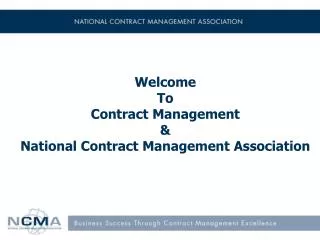
Welcome To Contract Management & National Contract Management Association
Welcome To Contract Management & National Contract Management Association Purpose: Introduce Universities and Colleges to – For More Information Neal Couture, CPCM at couture@ncmahq.org The Contract Management Profession National Contract Management Association
633 views • 22 slides
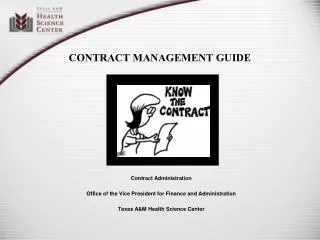
CONTRACT MANAGEMENT GUIDE
CONTRACT MANAGEMENT GUIDE. Contract Administration Office of the Vice President for Finance and Administration Texas A&M Health Science Center. CONTRACT APPROVED. Mission .
778 views • 29 slides
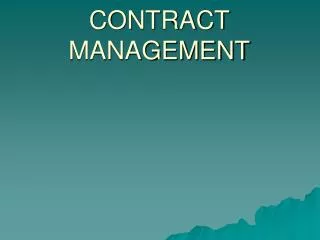
CONTRACT MANAGEMENT
CONTRACT MANAGEMENT. AN AGREEMENT ENFORCEABLE BY LAW IS A CONTRACT. Types of Contracts. Purchase order for stores, spares or equipment Rate Contract Service Contract Annual Maintenance Contract Works Contract Consultancy Contract. Statutory Provisions Governing Purchase Transaction.
1.41k views • 32 slides

CONTRACT MANAGEMENT
CONTRACT MANAGEMENT. Presented by: Kathleen Baxter, C.P.M. Supervising Contracts and Programs Administrator Inland Empire Utilities Agency 6075 Kimball Avenue Chino, CA 91708. CONTRACT MANAGEMENT OVERVIEW. Welcome!. Contract Management Contract Development Contract Negotiations
516 views • 15 slides
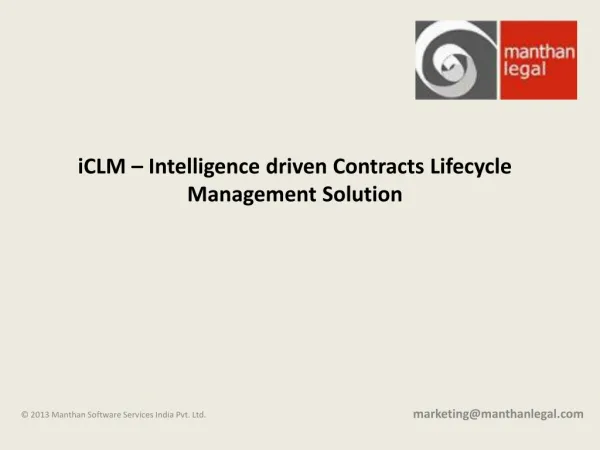
Contract Lifecycle Management
ENCOBI- ENterprise COntracts Business Intelligence is a new generation platform to enable end to end contract lifecycle management in organization of all sizes across industries which are signing more than 500 contracts in a year. Contracts management software - the concept itself is to utilize synthesized information to help CEO, CFO, COO and other decision makers to take informed decisions well in advance; which is key for any organization to rapidly enhance ROI and operate flawlessly in a risk averse environment.It is powered with intelligence driven features like contracts drafting, digital signage and contracts redlining with a robust reporting engine
449 views • 24 slides

Contract Management Solutions
Contract Management Solutions. What is Contract Lifecycle Management?. Contract Lifecycle Management (CLM ) is the capability to manage multiple legal document types through each stage in the contract lifecycle and transact across operational processes. Contract Lifecycle Management.
328 views • 0 slides
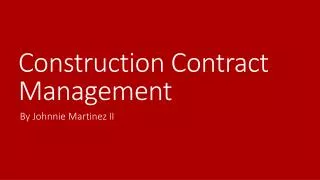
Construction Contract Management
Construction Contract Management . By Johnnie Martinez II. Why I am Interested .
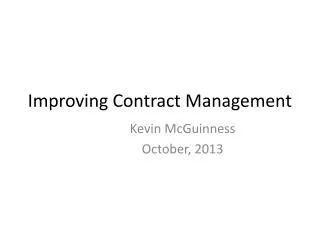
Improving Contract Management
Improving Contract Management. Kevin McGuinness October, 2013. Subjects Covered. Preliminary Questions Core Area Questions Creating a Contract Management Process Conclusion. Preliminary Questions. Preliminary, cont’d. What constitutes a contract? What types of contract are there?
898 views • 60 slides

Supplier Contract Management
Supplier Contract Management. What is Supplier Contract Management? Business Process Flow. 1. Establish Standards. 2. Author & Negotiate. 3. Approve and Sign. Best-practice configurators Role-based authoring Substitute and non-standard clauses Full term visibility.
879 views • 35 slides

Contract Management
Contract Management. Implementing Strategic Sourcing Best Practices in a Research Intensive Teaching Organization John P. Willi, MBA, CPCM, C.P.M., A.P.P., CMRP Dana-Farber Cancer institute, Boston, MA. Contract Management. Organizational Structure. DFCI Background
549 views • 23 slides

Global Contract Management
Global Contract Management. Ron Smith Commercial Contracting Conference 2003. Global Contract Management. Management processes & cycles Project cycles Contract cycles Contract management relationships Organization options Global Contract Management issues. Project Cycles.
525 views • 15 slides
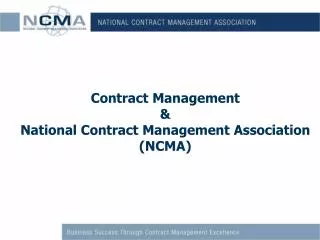
Contract Management & National Contract Management Association (NCMA)
Contract Management & National Contract Management Association (NCMA). Purpose: Introduce Young Professionals, Universities and Colleges to –. National Contract Management Association The Contract Management (CM) Profession Benefits of student membership in NCMA
473 views • 19 slides

Contract Management
Contract Management. Presentation by Simon Gresham. About Me. 30 years working in contracting environment Started in catering Worked on first local authority compulsory competitive tendering Moved on to market testing of central government services Worked on major accommodation PFIs
812 views • 34 slides
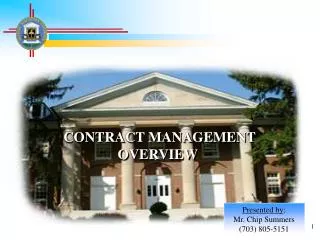
CONTRACT MANAGEMENT OVERVIEW
CONTRACT MANAGEMENT OVERVIEW. Presented by : Mr. Chip Summers (703) 805-5151. Contract Management. Contracting Environment Acquisition Planning Selecting the Source Contract Administration. Go to end of briefing. Contracting Environment. Contracting Activities Sequence
733 views • 45 slides

Contract Management
Contract Management. What is a Contract?. Agreement between two parties (both sides think they will benefit) Legally enforceable. Contract defines important parameters of the agreement. Scope of what is being exchanged Schedule Price Risk sharing. Why enter into a contract?.
633 views • 16 slides

Contract Management Services
If you handle loads of contracts, you can save time and money via contract management services. Through these services, every contract will be easy to retrieve and used as desired. Without wasting time, open ContractSafe and start managing your contracts like a focused professional. Other than making your processes extremely easy, quick and effective, these managers will help you administer all your contractual agreements in a flawless manner. The entire search will be cloud-based, accurate and instant. So, stop wasting time looking for that contract you need. ContractSafe gives you contract speed searching even in scanned documents. Automatic OCR of every document means it’s easy to find the document you need instantly. ContractSafe provides unparalleled contract management services. In a matter of days, your search system will be fully implemented and up and running.
205 views • 4 slides
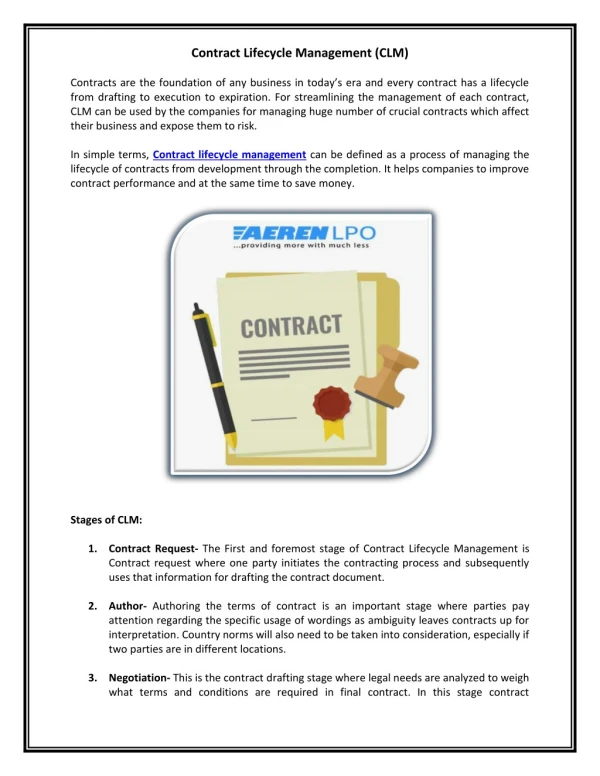
Contract Lifecycle Management
Contract Lifecycle Management can be defined as a process of managing the lifecycle of contracts from development through the completion. It helps companies to improve contract performance and at the same time to save money. for more info Visit us https://www.aerenlpo.com/
136 views • 2 slides
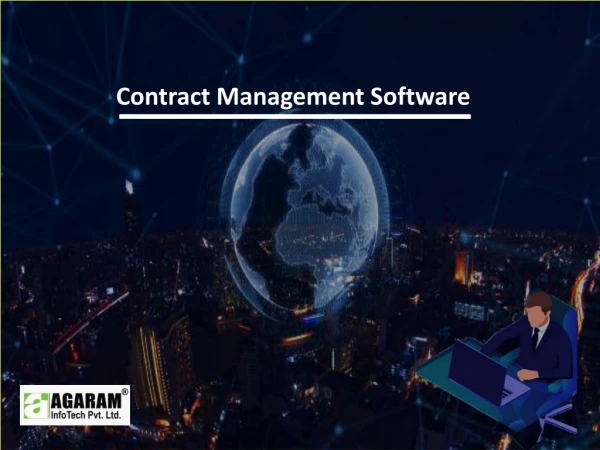
Contract Management Software
Now it becomes easier to streamline your contract lifecycle process with our effective contract management software. Agaram Infotech designs the software to suit your complex and challenging needs in best ways.

Contract Management
Contract Management. Outline. practices Bethlehem Steel Corp. clincial service elements in a contract examples. 2. Contract. the document defines terms and specify relationship, conditions, obligations and rights to be discussed and eventually approved by relevant parties
337 views • 26 slides

Contract Management Software
Au00a0contract lifecycle management systemu00a0can track all your contacts as well as notify you while payments with renewals are due. When this type of system is used, everybody is certain that all parties involved meet up with all the expectations that were highlighted in the agreement. You can effortlessly review and reclaim contracts while using a system. http://www.convergepoint.com/contract-management-software/

Contract Management System
Four Business Solution - At Four, we want to get to know you. We donu2019t offer standard solutions. We believe that every business, big or small, is unique. Yes, we have a suite of high-tech applications for workflow, supply chain procurement and contract management. But we also design a tailored solution for every customer u2013 to exactly meet their needs u2013 including software, e-learning and integration services. www.four.co.uk Four Business Solution - At Four, we want to get to know you. We donu2019t offer standard solutions. We believe that every business, big or small, is unique. Yes, we have a suite of high-tech applications for workflow, supply chain procurement and contract management. But we also design a tailored solution for every customer u2013 to exactly meet their needs u2013 including software, e-learning and integration services. www.four.co.uk
179 views • 5 slides

Healthcare Contract Management
Do you want to know what healthcare contract management is? Letu2019s read this article & learn about the healthcare contract and policy management processes.
134 views • 8 slides
























